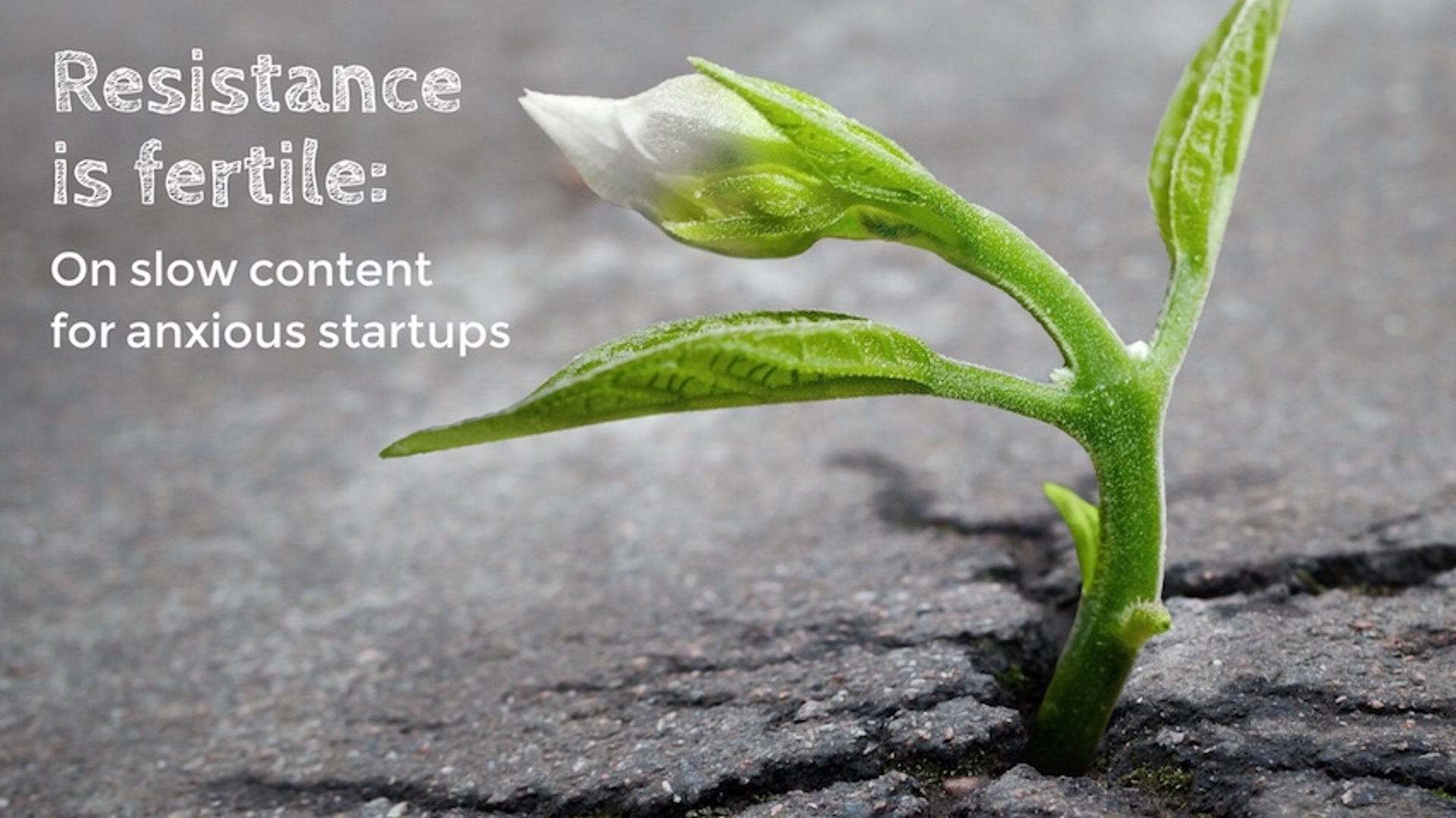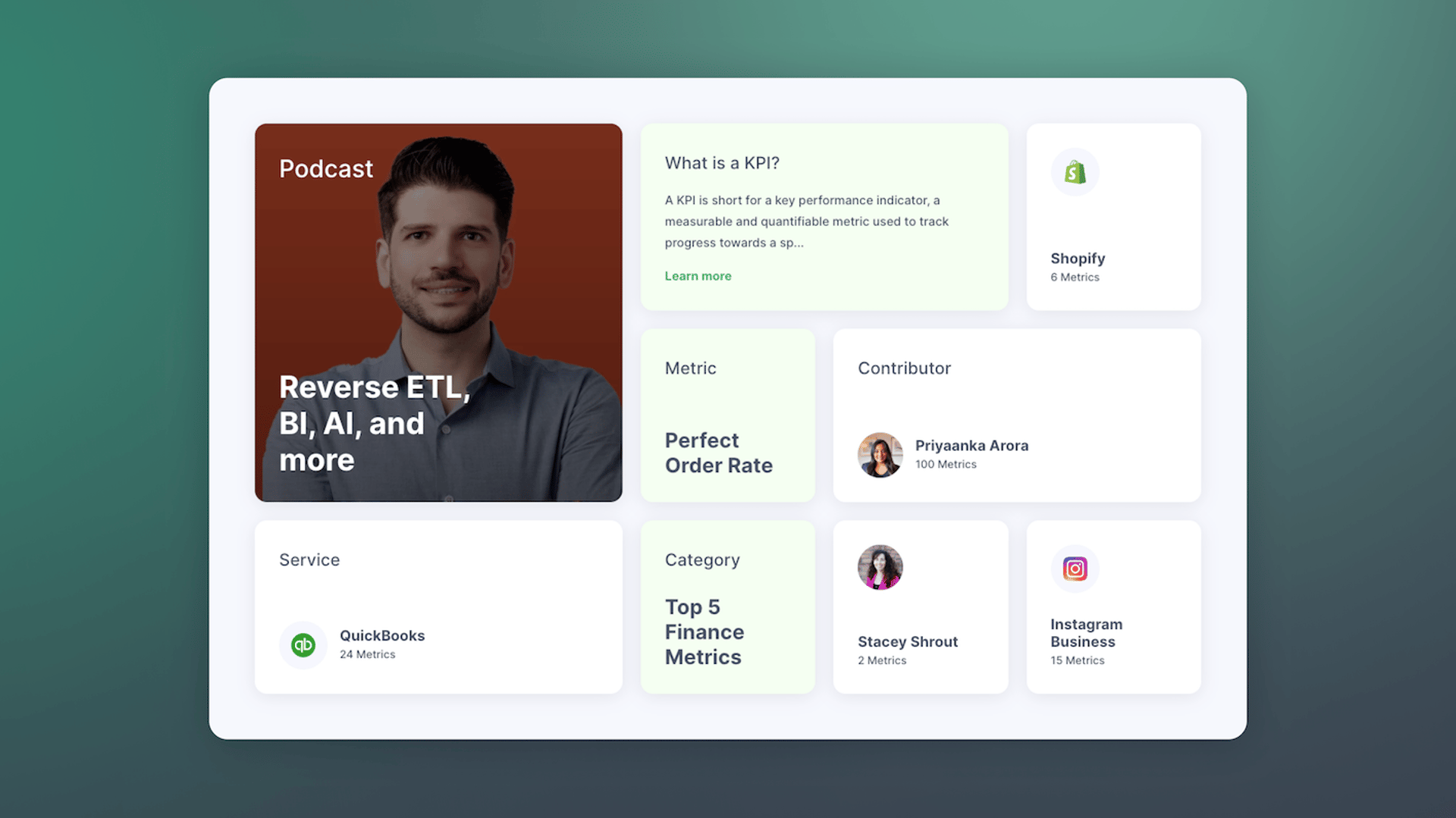Resistance is fertile: On slow content for anxious startups

Published 2025-12-23
Summary - Startups, writes Paul Graham, "are designed to grow fast." But slow content is often the best for content marketing. Is it possible to balance both? Yes.
I've yet to meet a startup team that wasn't, in part, driven by anxiety.
I'm talking about an actual startup, not some in-house innovation initiative under the umbrella of a wildly successful enterprise—and not some already successful company that claims to still "think like a startup."
Startups, writes Paul Graham, "are designed to grow fast."
Speed is often a necessity, especially because a startup with an idea likely isn't the only startup with that idea. Who can capture the market first? Who can secure the funding necessary to scale?
It's this speed, and dare I say the resulting anxiety, that can make startups such exciting and stressful places to work.
There's a complacency that comes from clocking in and putting in a 9-to-5 at a bank that's been around for 150 years that will simply never exist inside a startup.
Startup growth is a race, like an equestrian performance sport, where you can see and feel your competitors all around you.
It's exciting to embark on something radically new that has a better chance of failing than succeeding. It can even be exciting to paint a vision, establish product/market fit, and build a team to bring the vision to life.
But it can be scary as hell. Failure often feels like it can come with a single wrong step, and success often seems like what may happen only after 12 rounds of going toe-to-toe.
The juxtaposition: content marketing and startup growth

Coca-Cola has Content 2020, an initiative to move from "creative excellence to content excellence."
Red Bull has the Red Bulletin Magazine.
Marriot has been referred to as a content marketing Mecca.
Nearly every company at the stage of those mentioned have invested heavily in content marketing, and their results routinely appear in all the industry magazines.
It's easy to see why content marketing can thrive inside billion-dollar companies. When you've got all the resources first to think like and then to build out an internal media company, it's not all that hard to find success.
But content marketing, in my opinion, is especially interesting inside the startup space—especially inside the fast-moving SaaS sector, where the monthly subscription model rules the throne and customers can typically leave whenever they want (e.g., whenever a new product on the block persuades them).
Content marketing for startups is a topic worthy of a book, so I want to focus on one particular aspect that I've found interesting over the years: most startups are built to grow fast; most content marketing is built to grow slowly.
Fast-growing startups that resist quick-fix mediocre content and that embrace slow content of quality will have a far better chance of being rewarded.
Indeed, resistance can be fertile. And in this regard, it's far easier said than done.
So that we're on the same page here:
What is content marketing?
Content marketing is the practice and process of consistently creating, distributing, analyzing, and optimizing valuable content for an audience defined by its potential to become a customer or otherwise engage in actions beneficial to a company.
Slow content and fast growth
Most content marketing efforts don't fail, they end. And startups are the perfect exemplar of this truism. Why? Three reasons:
- They can't afford it (content marketing isn't free);
- They set unrealistic content marketing expectations;
- They lacked patience.
So what is slow content?

Using examples from where I live, the San Francisco Public Press is driven primarily by slow content.
They create in-depth stories about the community. These stories take time to produce.
Their content doesn't ride the immediate news waves (e.g., an accident took place here, there's a new restaurant opening there.), but they can ride the longer, smoother industry waves to create stellar, valuable content that is quoted and cited for years to come.
The San Francisco Chronicle, however, is driven primarily by fast content. While they do produce fantastic works of investigative reporting, they survive by churning out many pieces of fast content per day.
Fast content is excellent at riding a news wave, tapping into what’s trending, and creating content that has a content tilt that is unique to the media company and/or particular contributors.
Outside of the news world, content marketing is typically "slow." It's slow because:
- Startup content teams are often quite small;
- It takes time to create and distribute valuable content;
- Building trust (and improving SEO) through content takes time.
How to make slow content work in startups
I've watched most episodes of Anthony Bourdain's No Reservations, and a major theme that runs throughout is how food often comes third. The ambiance and energy, in some order, come first and second. They set the scene for the food.
There's a similar dynamic that is particularly the case in regards to content in startups: content comes third.
Controversial, I know.
First and second: strategy and communication.
On strategy
A content team, even if it's just a few people pitching in to create and publish, must have a proper strategy in place.
What topics in the arena of the company's chief domain are they going to cover? Are competitors already doing it? What will be the content cadence? Who will be the creators? What content metrics and KPIs will they be monitoring? And ultimately: who is the audience and why will they seriously need such content?
On communication
If a startup, particularly the leadership team of a startup, isn't sure what content marketing is, the resources it demands, and the time it takes to execute successfully, there will at some point be immense friction—the type of friction that means a content marketing effort comes to an end.
Avoiding this friction means the content team, after creating a strategy and the processes to orchestrate that strategy, must effectively communicate the why of what they are doing.
Most content teams drop the ball here. They assume the wider company understands, or because there is so much to do they get caught up in putting their heads down to drive results and forget to look up to communicate those results or the why of their work.
Balancing slow content and fast content

An in-house content marketing strategy capable of producing slow content and fast content will have struck a unique balance.
They'll benefit from the long-term benefits of building a trusting audience and establishing some level of search engine domain authority on topics, and they'll be able to ride news waves that are happening in their industry.
If your company is sponsoring a conference, for example, the content team can create fast content that will at once ride the social media (and hashtag) of the event, while also providing value to those who were unable to attend.
Just be sure to keep in mind that the slow content (like those evergreen blog posts you've been writing for months) should be the constant in your startup's content marketing strategy.
Slow content is the fertile soil upon which everything else can grow.
See Also:
Related Articles

Why Are KPIs Important?
By Danielle Poleski — August 5th, 2025
What is Product-Led Growth?
By Emily Hayward — May 12th, 2025
How smart businesses are making better decisions
By Alastair Barlow — November 22nd, 2023

